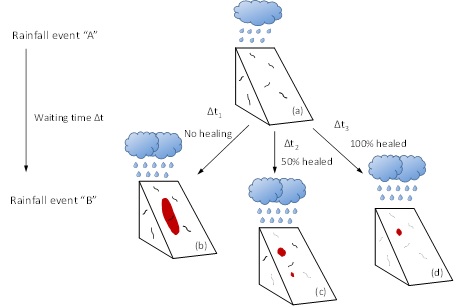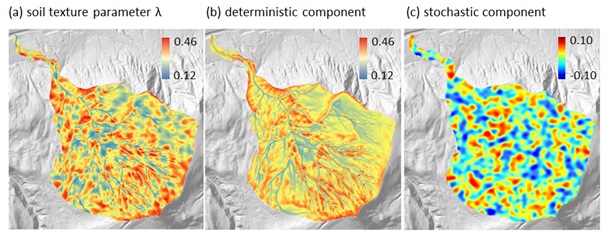References
Here a list of publications with more details on details of modeling approach:
Fan, L., P. Lehmann, and D. Or, 2017, Load redistribution rules for progressive failure in shallow landslides: Threshold mechanical models, Geophysical Research Letters, 44, 228–235, doi:10.1002/2016GL071763.
Fan, L., P. Lehmann, B. McArdell, and D. Or, 2017, Linking rainfall-induced landslides with debris flows runout patterns towards catchment scale hazard assessment, Geomorphology, 280, 1–15, http://dx.doi.org/10.1016/j.geomorph.2016.10.007
Fan, L., P. Lehmann, and D. Or. 2016, Effects of soil spatial variability at the hillslope and catchment scales on characteristics of rainfall-induced landslides, Water Resources Research, 52, 1781–1799, doi:10.1002/
2015WR017758.
Fan, L., P. Lehmann and D. Or, 2015, Effects of hillslope hydromechanical loading history on antecedent damage and shallow landslide triggering characteristics, Journal of Geophysical Research F, Earth Surface, 120(10), 1990-2015.
Von Ruette J., P. Lehmann, and D. Or, 2015, Linking localized rainfall-induced landslides with predictions of debris flow runout distances, Landslides, doi: 10.1007/s10346-015-0621-2
Von Ruette J., P. Lehmann, and D. Or, 2013, Effects on rainfall spatial variability and intermittency on shallow landslide triggering patterns at a catchment scale, Water Resources Research, 50, (10), 7780-7799, DOI: 10.1002/2013WR015122
Von Ruette, J., P. Lehmann, and D. Or, 2013, Rainfall-triggered shallow landslides at catchment scale - threshold mechanics-based modeling for abruptness and localization, Water Resources Research, 49, 6266-6285, 10.1002/wrcr.20418
Von Ruette, J., A. Papritz, P. Lehmann, C. Rickli and D. Or, 2011, Spatial statistical modeling of shallow landslides - validating predictions for different landslide inventories and rainfall events, Geomorphology, 133, (1-2), 11-22, doi: 10.1016/j.geomorph.2011.06.010
Lehmann, P., and D. Or, 2012, Hydromechanical triggering of landslides: From progressive local failures to mass release, Water Resources Research, 48, W03535
Below you can find three Applications of the model concept
Application 1: Effects of hydromechanical loading history and antecedent soil mechanical damage on shallow landslide triggering
The abrupt triggering of rainfall-induced shallow landslides is preceded by accumulation of local internal failures in the soil mantle before their coalescence into a landslide failure plane. The mechanical status of a hillslope at any given time reflects a competition between local damage accumulated during antecedent rainfall events and rates of mechanical healing (e.g., re-bonding of microcracks and root regrowth, which determines the initial mechanical state for landslide modeling. We applied this landslide triggering model to investigate the influence of the interplay between antecedent damage and mechanical healing on the timing, locations and volumes of future landslides triggered in future rainfall events. We employ a hypothetical initial rainfall event that inflicts damage on a hillslope and evaluate how a subsequent rainfall event triggers landslides. The first rainfall event (termed rainfall event “A”) induces local damage within a slope and forms the initial conditions for subsequent rainfall events. During the time interval to next rainfall event (rainfall event “B”), the mechanical damage may heal and soil strength recovers. The healing mechanisms could involve grain bonding by cementing agents, more stable rearrangement of soil particles, closure of micro-cracks, reformation of capillary bridges, and regrowth of roots across cracks. This study highlights the importance of antecedent mechanical damage and subsequent healing processes on failure dynamics and patterns of rainfall-induced shallow landslides in soil material.

Application 2: Effects of Soil Spatial Variability on Characteristics of Rainfall-Induced Landslides
Spatial variations in soil properties affect key hydrological processes and soil mechanical response to hydro-mechanical loading, and thus the characteristics of rainfall-induced landslides. This landslide triggering model has been applied to assess the role of the spatial variation of initial water content and soil texture on the landslide characteristics at the hillslope- and catchment-scales. At the hillslope scale, soil spatial variation is modeled as random distribution with prescribed mean, standard deviation and spatial correlation length. At the catchment scale, initial water content was linked to landscape topographic wetness index, whereas the soil texture parameter varied deterministically with soil depth with a spatially correlated stochastic residual. The generated spatial variable initial water content and soil texture are then used as inputs for the landslide triggering model. This study gives first order estimates of the sensitivity of landslide triggering on spatial variability and provides a framework to quantify the effects of both the randomness and structural organization of soil properties on the triggering characteristics of rainfall-induced shallow landslides.
Application 3: Effects of rainfall patterns on landslide triggering
The occurrence of shallow landslides is often associated with intense and prolonged rainfall events, where infiltrating water reduces soil strength and may lead to abrupt mass release. Despite general understanding of the role of rainfall water in slope stability, an often overlooked and potentially important factor is the role of rainfall variability in space and time on landslide triggering that is often obscured by coarse information (e.g., hourly radar data at spatial resolution of a few kilometers). To quantify potential effects of rainfall variability on failure dynamics, spatial patterns, landslide numbers and volumes, we employed the model for a study area where a summer storm in 2002 triggered 51 shallow landslides. In numerical experiments based on the CHLT model, we applied the measured rainfall amount of 53 mm in different artificial spatiotemporal rainfall patterns, resulting in between 30 and 100 landslides and total released soil volumes between 3000 and 60,000 m3 for the various scenarios. Results indicate that low intensity rainfall below soil’s infiltration capacity resulted in the largest mechanical perturbation. This study illustrates how small-scale rainfall variability that is often overlooked by present operational rainfall data may play a key role in shaping landslide patterns.
In the figure below we present (for two different initial water contents at onset of rainfall) the different landslide numbers and volumes obtained for distributing 53 mm of rainfall in various temporal (one or two rainfall ‘steps’ or according to the measured evolution of rainfall rate) and spatial patterns (measured distribution and artificial rainfall patterns). The figure shows that rainfall variability can have a huge effect on triggering.

